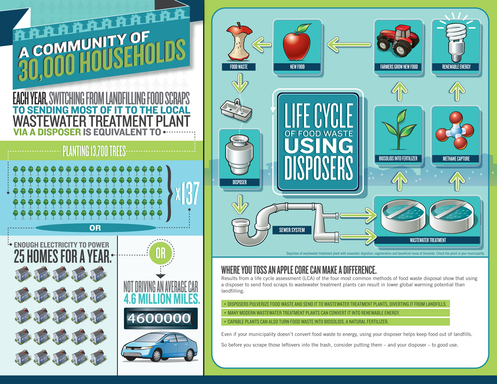A new study about the impact of various food waste disposal systems says putting it into a garbage disposer results in lower global warming potential than putting it in the trash and sending it to a landfill.
According to the EPA, landfills are a major source of methane, a greenhouse gas at least 21 times more potent than carbon dioxide. Because food scraps are a significant component of waste that municipalities send to landfills, diverting it for recycling into resources is becoming a major goal of cities worldwide. Enter food waste disposers, which pulverize food scraps and send the resulting slurry to the various wastewater treatment systems.
Yes, yes, this key finding of the Life Cycle Assessment (LCA) was commissioned by InSinkErator, a manufacturer of food waste disposers, but if you believe funding source invalidates research, then 2.5 years of studies don't count for Republicans.
In the analysis, if a community of 30,000 households (e.g. the size of Newport Beach, Calif.) switched from sending food scraps to the landfill to using a disposer instead, the reduction in global warming potential would be the equivalent of eliminating nearly 2,100 tons of carbon dioxide emissions. That is about 4.6 million miles of car traffic.
Many advanced wastewater treatment plants can convert food scraps into renewable energy through anaerobic digestion. At these plants food scraps can also be turned into fertilizer products, also known as biosolids, which can help build healthy soils.
“The LCA confirms a multitude of research and validates that food waste disposers are more than just convenient – I like to think of them as an environmental appliance,” said Tim Ferry, president, InSinkErator. “After people look at the environmental benefits of using disposers instead of landfills, we think they will be compelled to bypass the trash can and put food scraps down the disposer instead.”
Unlike studies that review and compare competing products, the LCA assesses the environmental impact of the four primary systems for managing food scraps – wastewater treatment, landfills, incineration and advanced composting. Camp Dresser&McKee (CDM) conducted the initial analysis used by PE INTERNATIONAL, Inc. to produce the LCA following ISO 14040 standards, including review by an independent panel of experts.
The LCA analyzed several critical environmental impacts: global warming potential (trapping heat that would otherwise pass out of the earth’s atmosphere), eutrophication potential (excessive vegetative growth in bodies of water from high concentrations of nutrients), acidification potential (increase in the acidity of water and soil), smog formation, and the energy demands associated with each system.
The report states that food scraps processed through a wastewater treatment plant with anaerobic digestion and co-generation (e.g., San Francisco, Milwaukee and many others) can even result in a reduction of global warming potential. It also concludes that processing of food scraps at these advanced wastewater treatment facilities has lower energy demand – less than landfills, incineration and centralized composting.
“In thinking about systems for managing food scraps, wastewater treatment systems are often overlooked despite their surprisingly effective role in turning liquid waste into valuable resources,” said Michael Keleman, senior environmental engineer, InSinkErator. “Composting is good but it isn’t the only option.”





Comments